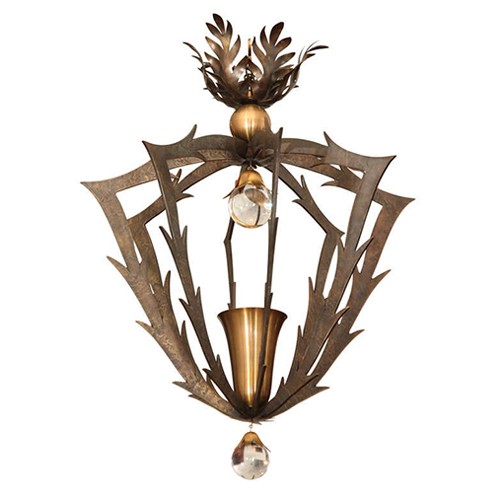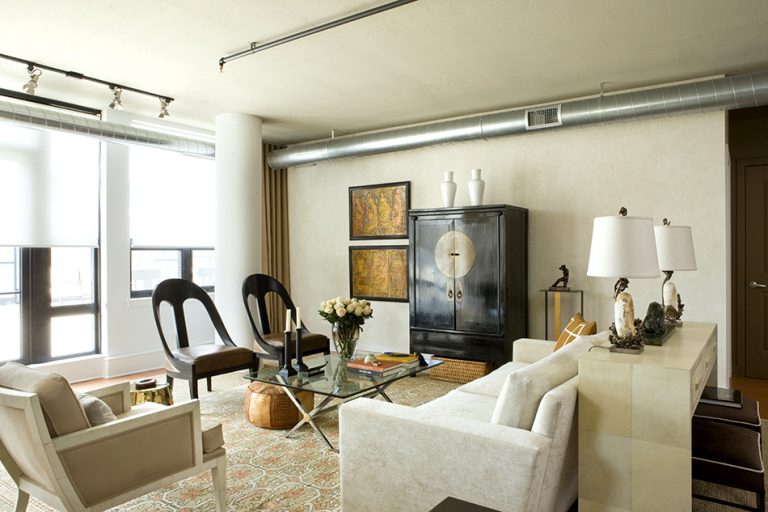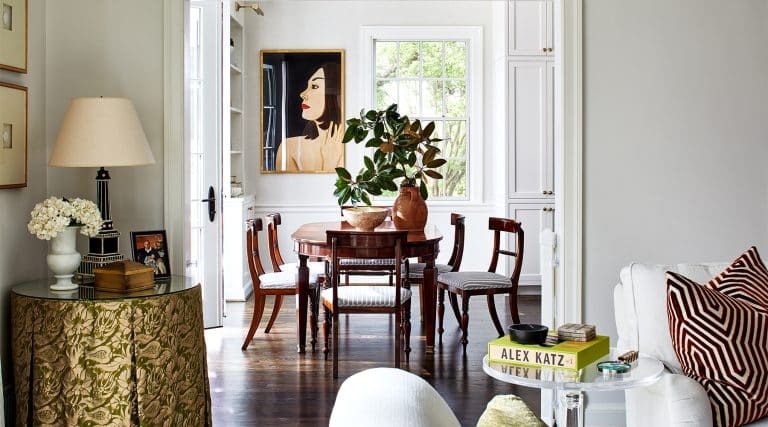
February 6, 2013In a Potomac, Maryland, house, the Cuban-born, Washington, D.C.–based designer Nestor Santa-Cruz curated eclecticism and understated chic. All photos by Angie Seckinger unless otherwise noted
Bertrand Russell once wrote, “The secret of happiness is this: Let your interests be as wide as possible.” This could serve handily as a mantra for Washington, D.C.–based interior designer Nestor Santa-Cruz, for it is largely the catholicity of his interests that has enabled him to lead such a busy and seemingly bifurcated life. Few people could simultaneously hold down a full-time job as a design director at Gensler — arguably the world’s largest commercial architecture firm, for which he logs an average of 100,000 international travel miles a year — and his own private residential design practice. A partial list of recent and ongoing projects includes a hotel in Afghanistan, a cottage in Boulder, corporate offices in both France and China for one of the world’s top law firms, a condo in D.C.’s Kalorama district and a large house in Reston, Virginia.
Yet he moves absolutely fluidly between these worlds. Tall, urbane and unflappable, almost always turned out in exquisitely cut Lanvin suits, Santa-Cruz radiates refinement. And though he’s too well-bred to be self-important, you get the distinct feeling that, most of the time, this is a man who knows more than you do.
Santa-Cruz’s insatiable curiosity — which translates into interiors that are consistently intelligent, worldly and chic — was molded by his parents from the moment he entered the world in Santiago de Cuba in 1958. His father, an IBM executive, was something of a Renaissance man. Studied in philosophy, “he was interested in art, literature, business, architecture, engineering, golf and tennis, classical music, photography, Cuban history…everything,” recalls Santa-Cruz. His mother, a schoolteacher, was “an artsy-craftsy person and a gourmet cook, and she had a naturally creative, intuitive design interest.”

At a residence in the Palisades neighborhood of D.C., bright green leather-paneled walls complement Fortuny curtains and side tables by Jean-Michel Frank.

For the lobby of a D.C. law firm, Santa-Cruz designed a minimalist rug and a coffee table made of recycled resin from the 3form company; the artwork is by the local artist Gene Davis. Photo by Paul Warchol
When Santa-Cruz was three years old, his father, realizing where Fidel Castro was leading the country, arranged to have the family transferred to Peru with IBM. (They would subsequently move on to Puerto Rico and El Salvador). “I have memories of waiting for a KLM flight to take us to Curaçao,” says the designer. “We left with the clothing on us that day, a coat and three sets of underwear. That was it. Everything else was left behind, lost.”
Many will contend that having the life you know abruptly vanish into thin air would leave you acutely aware that nothing lasts forever. You could either become bitter and take to living in the past or decide to view anything and everything as a doorway to a new, richer life. Santa-Cruz opted for the latter, voraciously seizing it all — new knowledge, new experiences, new points of view — as if he would never have the opportunity again.
In particular, he became a sponge for all things artistic and architectural. At five, he was constructing complex wood-block houses, and, at eight, he was persuading his two brothers to pool their allowance from their grandfather to buy extra Lego sets. At 12, he was taking drawing lessons with the most renowned Salvadoran painters of the day — Armando Solís, Victor Barriere and Carlos Cañas — while living amid mid-century modern furniture by Wegner, Risom, Saarinen and others, purchased by his father from the Danish ambassador to El Salvador.
During his teenage years, Santa-Cruz began funneling that same allowance into subscriptions to Architectural Digest and GQ. IBM’s in-house architects, impressed with the boy’s enthusiasm and talent, passed on their own Architectural Record magazines as well, and one of them presented Santa-Cruz with a set of monographs of famous architects: Aalto, Le Corbusier, Niemeyer, Wright. Santa-Cruz claims to have known he would study architecture from the age of eight. But, he observes, “There was already a dichotomy — design and architecture — though I didn’t realize it at the time.”
“A story on the Paris apartment of Yves Saint Laurent and Pierre Bergé in a 1976 issue of Architectural Digest set Santa-Cruz on his way: “Its variety of periods and genres showed me what style could be.”

Santa-Cruz purchased the rug for a 1960s ranch-style house in The Plains Virginia, through 1stdibs dealer Maison Gerard; the sofa is by Albert Hadley.

Demonstrating his range, Santa-Cruz decorated a skateboard shop in the trendy Northwest neighborhood of D.C.; for this project, he used all Scandinavian furniture.
He credits one issue of AD — September/October 1976 — with first setting him on the path that lead to the present. It showcased the Paris apartment of Yves Saint Laurent and Pierre Bergé (“Its variety of periods and genres sent me a message about what style could be”); an essay on Jean-Michel Frank by Van Day Truex; and several spreads on the San Juan duplex of Cuban-exile and fashion designer Fernando Peña, which was one of the last projects decorated by Maison Jansen’s New York office. To this day, a lively mix of styles and periods, almost always punctuated with pieces by (or inspired by) Jean-Michel Frank and Maison Jansen are hallmarks of the Santa-Cruz aesthetic.
Onto that basic framework, Santa-Cruz grafts elements that could practically be considered promiscuous in their diversity: Berber rugs, mid-century modern furniture, African tables and stools, Italian lighting, American Abstract Expressionist art, 18th-century bérgères, flea-market finds, fabrics and colors influenced by contemporary fashion, and books, books, books.
Santa-Cruz began architecture studies at the University of Arkansas, drawn there because it was headed by Fay Jones, a disciple of Frank Lloyd Wright. Wright was one of Santa-Cruz’s great idols not only for his exquisite buildings, but because Wright created complete environments — designing tableware, furniture, fabrics and other interior elements — something the budding designer also longed to do. He continued on to Virginia Tech, a liberal arts university that let him explore a wide range of subjects while still getting a master’s in architecture.
After graduating, his career in commercial design began in Washington, D.C., at Swanke Hayden Connell, which hired him primarily to handle interior aspects of the buildings they designed. His next stop was Skidmore Owings & Merrill, where, in the late 1990s, Santa-Cruz began exploring residential design. “SOM did it for only select clients, all of them captains of industry,” he says. “It gave me a taste of residential in a formal way.”

The family room in the Potomac house gets a contemporary twist from a table by Norman Foster for Tecno, surrounded by re-editions of iconic chairs by Hans Wegner and Arne Jacobsen; the disco-ball light fixture is from the Italian company Terzani.

For her Palm Beach pied-à-terre, the pianist Mary Kathleen Ernst requested “Sweden meets Park Ave.” Santa-Cruz, who says this look is representative of his newer work, added a mirror from 1stdibs dealer David Bell and limestone floors to mimic the look of sand.
In 1996, Santa-Cruz’s apartment appeared in Metropolitan Home, which christened him one of “14 Designers to Watch,” and the following year, the same apartment, now redecorated, appeared in Southern Accents as part of a round-up of “Four Under 40” designers.
Santa-Cruz was on his way: In 2003, he established his own design firm. By 2004, he had been inducted into the Washington Design Hall of Fame. Four years later he joined Gensler as one of its design directors, where he remains today, while simultaneously running his residential design business.
His commercial work, he says, is most influenced by his architectural education. “I’m a believer in form follows function and less is more,” he explains. There is also precision, restraint, an elegant sense of scale and an element of surprise (a sculptural chair, a wall painted a deeply saturated color). His residential oeuvre displays these qualities as well, but it also exudes a curated eclecticism and an understated chic. The fabrics are luxurious, the materials often expensive, the juxtapositions bold, yet always balanced and never overdone. Silhouettes of even the most ornate furnishings appear startlingly crisp against his comfortably spare rooms. Rather than using the self-conscious or boastful combinations many designers favor today, Santa-Cruz creates conversations between his stylistic and historic pairings. This all takes tremendous discipline.
Finally, whether commercial or residential, one cannot fail to detect that the person who pulled together these interiors is someone who knows the world. “I couldn’t do what I do without the inspiration I get from travel,” grants Santa-Cruz.
Today, his thirst for new experience and exposure remains unquenched. “I’m 54, and I feel as young today in design as when I had no education in it,” he says. “My passion is about what’s out there — past, present and future.”









